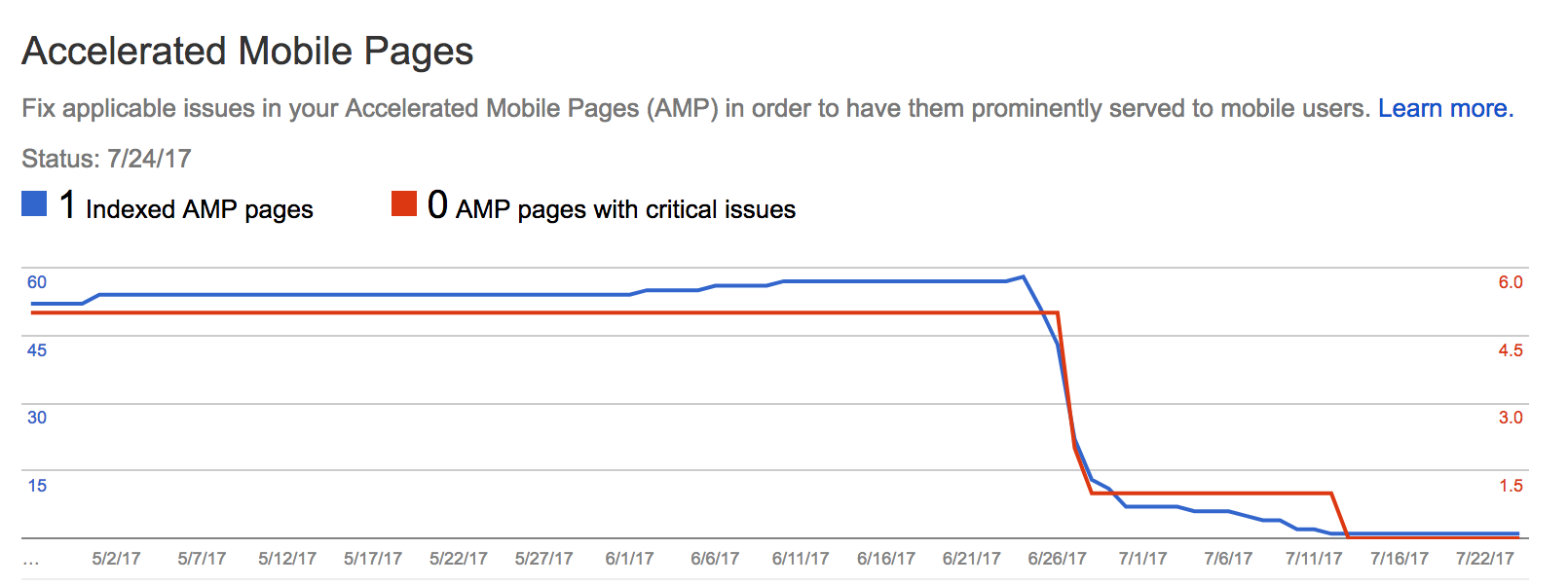One month ago I decided to disable Accelerated Mobile Pages (AMP) support on my site. This is a quick follow up on my experience so far and some metrics. In summary, I like it.
Proof that it’s gone
The following image captured in Google Webmaster’s Search Console indicates that the total count of AMP pages on my site went from about 60 to 0.

Count of AMP Pages
The following image indicate that AMP impressions went down from 7K to less than 150, when compared to a similar time period a month ago. The 150 count likely indicates that it took some time from AMP results for my site to clear out from Google search.

AMP Impressions
Effect on Search Traffic
It seems that Google in fact does NOT penalize websites for NOT having AMP support.
Here is my traffic according to Google Analytics, filtered to only show results that came from Google Search. The results are displayed for the past month and compared to a similar time period in the prior month.
Traffic rate appears to stay roughly the same and all metrics appear to improve. To be fair, I did publish four new articles since I disabled AMP, so my numbers could have had a nice bump from the new content.

Google Analytics Traffic
Last but not least, here are the stats that I have from Google Webmaster’s Search Console.

Webmaster’s Search Console Traffic
My Click Through Rate (number of clicks / number of impressions) actually went DOWN from 4.74% to 3.15%. My average position also went down from 26.5 to 44.4. But my number of impressions went UP from 166K to 252K.
As I mentioned earlier, that shift could be due to new content that I published, including Reverse Engineering One Line of JavaScript, which showed up in Google more, but at a much lower positions, skewing the numbers. I am not sure if these numbers co-relate directly with the removal of AMP, especially considering that AMP traffic accounted for only 7K visits, as can be seen at the top of this post.
To further confirm that my existing search rankings were not penalized, I filtered metrics for the top three search terms from the previous month.

Git Tips – Average position declined from 2.4 to 2.9

Angular Performance – Average position improved from 2.4 to 2.3

Node JS Memory Leak – Average position improved from 3.4 to 2.9
All in all, these numbers appears to show a “regular” fluctuation due to whatever magic Google’s search algorithm is doing. I feel confident that removing AMP did not affect my search result rankings.
Effect on Me
Believe it or not, but I feel happier. I enabled AMP on my site because I felt that it would make Google happy and would help my search rankings. At the same time I did not like my (default for WordPress) implementation of AMP. I knew there were a lot of issues with it, which I didn’t have time to fix. So every time I would see an AMP result in Google Search on my mobile, I would cringe, because it would remind me of all the troubles that I had with AMP.
Now AMP does not upset me nearly as much. I even found myself liking an AMP version of a site that otherwise had a lot of ads on it. Knowing that I don’t have to support AMP as a publisher, makes me hate it less as a user.
Another benefit of not having AMP serve as an excuse for my site being “mobile friendly”, is that I began to care more about my site ACTUALLY being mobile friendly. I was able to identified a number of performance bottlenecks, which I am now addressing.
Conclusion
AMP is not for everyone. I will repeat. AMP IS NOT FOR EVERYONE.
If you are going to implement AMP, make sure to implement it right. You can read my other article on the subject for practical advice and some pitfalls to avoid.
Ironically, the only sites that can benefit from AMP are the sites that have the resources needed to implement a highly optimized mobile version. For example, BBC has a great AMP page that feels almost like a native site. At the same time BBC’s mobile site is so great, that I don’t really need the AMP version to have a good experience.
Unless you run a News site that HAS to compete for a spot in Google Carousel enabling AMP is not worth the effort. AMP is an alternative publishing format and most small site can’t afford to maintain two (quality) versions of itself.
Since not having AMP support does not result in a Google Search penalty, why bother?